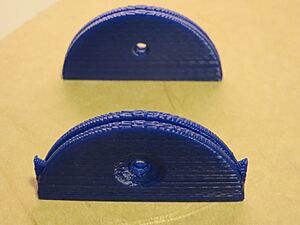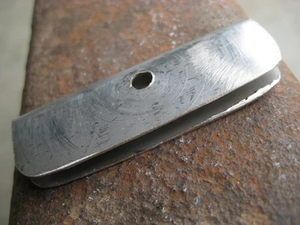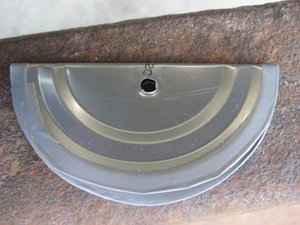Shepherd's whistle facts for kids
A shepherd's whistle is a special kind of whistle used to talk to and train working dogs, like sheepdogs. Unlike most whistles, you put this one inside your mouth. You change the sound (or 'pitch') by moving your tongue, making it a bit like playing a vessel flute with your mouth. Even though they look simple, shepherd's whistles can make many different sounds, just like tin whistles.
Contents
Why Use a Shepherd's Whistle?
Shepherds use these whistles to give clear commands to their sheepdogs when herding sheep. They are often seen at sheepdog trials, which are like competitions for working dogs. These whistles are also used for other working dogs, like gundogs, and even in falconry (training falcons).
Shepherd's whistles make clear, high-pitched sounds that dogs can hear from far away, even up to 2 miles (3.2 km)! The sound can be changed a lot, so shepherds can send many different messages to their dogs. The high pitch is perfect for a dog's hearing and can travel well, even in bad weather.
There are some common whistle commands, but each shepherd might have their own special signals. If you are herding a big group of sheep with two or three dogs, you can control each dog by whistling a special tune that only that dog knows.
What Are Shepherd's Whistles Made From?
Long ago, people made these whistles from simple things like folded metal cut from a tin can or a jam lid. They would punch a hole and smooth any sharp edges.
Today, you can buy them in stores. Simple ones can be very cheap, while fancy ones can be quite expensive. They are often made from plastic, aluminum, stainless steel, or even special materials like silver, brass, titanium, or jade. The material can change how loud the whistle is, its unique sound (called 'timbre'), and how many different pitches it can make.
How Are Shepherd's Whistles Designed?
The size of a shepherd's whistle can change to fit the person using it. Most whistles are flat and shaped like a half-circle, folded in the middle. This creates a very narrow U-shape when you look at it from the side, with a small gap of about 4–5 mm. A small hole is drilled through both sides, about 5 mm from the fold.
The whistle can also be made in other shapes, like squares, rectangles, or even triangles. Some designs include handles or a hole so you can wear the whistle like a pendant (a hanging charm). Some whistles have two holes to make them even louder!
How to Use a Shepherd's Whistle
Using a shepherd's whistle is different from using a regular whistle.
You push the whistle into your mouth with the folded side first. The open, curved part of the U-shape is where the air comes out. Your lips seal around the outside edges of the whistle. You should be able to see the folded part of the whistle between your lips. The back of the folded part rests against your tongue, but your tongue must not block the holes.
When you blow, air travels over your tongue, through the top hole, past the top of the bottom hole, and out of your mouth. The edge of the hole acts like a special lip that helps create the sound. The lower hole opens into a closed space between the whistle and the bottom of your mouth. This space acts like a 'sound box,' making the sound louder and clearer. It's similar to how blowing across the top of a bottle makes a sound.
Unlike regular whistles that make only one sound, the shepherd's whistle can make many different pitches. You do this by moving your tongue and changing the shape and size of the 'sound box' inside your mouth. This changes the sound (or 'resonance'). You can learn more about this in articles about vessel flutes.
You can make a range of sounds covering more than an octave (like going from one 'C' note to the next 'C' note on a piano). Whistles made from denser materials usually have a wider range of sounds and can be louder.
When a dog is first trained, they learn commands using both your voice and the whistle. Once the dog understands the whistle commands well, you can stop using your voice. You can also make commands longer or louder to get your dog's attention.
See also
- Human–animal communication
- Dog whistle
- Vessel flute




